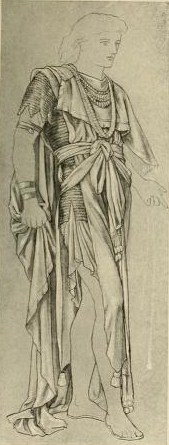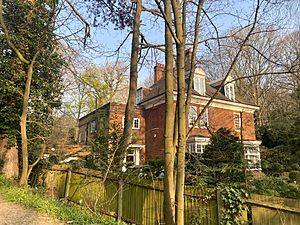Henry Holiday facts for kids
Quick facts for kids
Henry Holiday
|
|
|---|---|
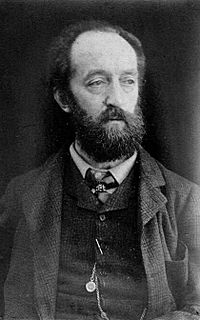
Henry Holiday in the 1870s
|
|
| Born | 17 June 1839 |
| Died | 15 April 1927 (aged 87) |
| Nationality | British |
| Education | Royal Academy Schools |
| Known for | Painting, stained-glass designer, illustrator, sculptor |
| Style | Romanticism |
| Movement | Pre-Raphaelite Brotherhood |
| Spouse(s) | Kate Holiday |
Henry Holiday (born June 17, 1839 – died April 15, 1927) was a talented English artist. He lived during the Victorian era. Henry Holiday was known for many things. He painted historical scenes and landscapes. He also designed beautiful stained-glass windows. Plus, he worked as an illustrator and a sculptor.
Holiday was greatly inspired by a group of artists called the Pre-Raphaelite Brotherhood. He knew many of these artists personally. Their ideas had a big impact on his art and his views on society.
Contents
Life and Art of Henry Holiday
Becoming an Artist
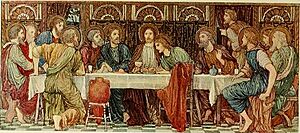
Henry Holiday was born in London. From a young age, he showed a natural talent for art. He took art lessons from William Cave Thomas. At just 15 years old, in 1855, he was accepted into the Royal Academy Schools. This was a very important art school.
Through his friends, he met famous artists like Dante Gabriel Rossetti and Edward Burne-Jones. These artists were part of the Pre-Raphaelite Brotherhood. This group believed art should be detailed and colorful, like art before the Renaissance. Their ideas shaped Holiday's future as an artist.
In 1855, Holiday also visited the Lake District in England. He loved the beautiful mountains and lakes there. He often returned to sketch the stunning views. He once wrote that nothing compared to the beauty of the Lake District.
His Paintings
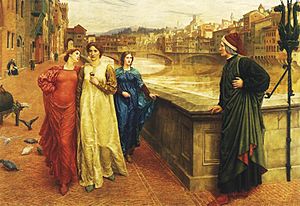
Henry Holiday used both oil paints and watercolors. In 1858, his first landscape painting was shown at the Royal Academy of Arts. It sold right away! After that, his artwork was often displayed in galleries.
Some of his famous paintings include:
- The Burgess of Calais (1859).
- The Bride and the Daughters of Jerusalem (1861–63). This was a very ambitious painting for him. It showed a scene from the Bible. The Royal Academy surprisingly rejected it at first. But other artists, like James McNeill Whistler, loved it. Whistler even joked about the Academy's poor choices. The painting was later bought, but its location is now unknown.
- The Rhine Maidens (1879). This painting was inspired by an opera by Wagner. To make it look real, Holiday made clay models of the characters. He even put them in a tank of blue-green water with clay "rocks"!
- Dante and Beatrice (1883). For this painting, Holiday traveled to Florence, Italy. He carefully studied the buildings and places to make sure they were accurate. He even made small clay models of buildings to plan the scene.
Holiday spent a lot of time with other artists, sharing ideas. He was especially influenced by Sir Edward Burne-Jones. You can see Burne-Jones's style in some of Holiday's work.
Stained Glass Art
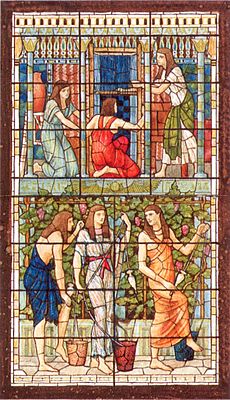
In 1861, Henry Holiday started designing stained-glass windows for Powell's Glass Works. He took over from Burne-Jones. During his time there, he completed over 300 projects. Many of these were for churches and buildings in the United States.
In 1891, he decided to open his own glass workshop in Hampstead, London. There, he created beautiful stained glass, mosaics, and other art pieces.
You can find Holiday's stained glass art all over Britain. Some of his best work is in places like Westminster Abbey and Worcester College, Oxford. In the United States, you can see his work in Grace Church in New York City.
Other Creative Works and Life
Henry Holiday also tried his hand at sculpture. In 1861, he made a sculpture called Sleep, which was well-received.
He worked with architect William Burges on several projects. This included painting walls and furniture for buildings like Worcester College, Oxford. One famous piece is the "Sleeping Beauty" bed, which he painted for Burges's home.
In 1864, Holiday married Catherine Raven. She was also an artist, known for her embroidery. They had one daughter named Winifred.
Holiday loved to travel. In 1867, he visited Italy and was inspired by the art of the Renaissance. In 1871, he went to Ceylon (now Sri Lanka) to draw astronomical events. His drawings were published and became very popular.
When he returned to England in 1872, he had a new home built in Hampstead. It was called "Oak Tree House."
A very interesting part of his career was when Lewis Carroll asked him to illustrate his famous poem, The Hunting of the Snark, in 1875. Holiday and Carroll remained friends for life.
Later in his life, Holiday traveled to Egypt. He painted many watercolors inspired by ancient Egyptian themes. He also designed a holiday home in his beloved Lake District.
Henry Holiday was a socialist and believed in equal rights for all people. He and his wife, Kate, strongly supported the Suffragette movement. This movement fought for women's right to vote. They even organized meetings in the Lake District to support the cause.
Henry Holiday passed away on April 15, 1927, in London. His nephew, Gilbert Holiday, also became a well-known artist.
See also
- Aestheticism
- British and Irish stained glass (1811–1918)


